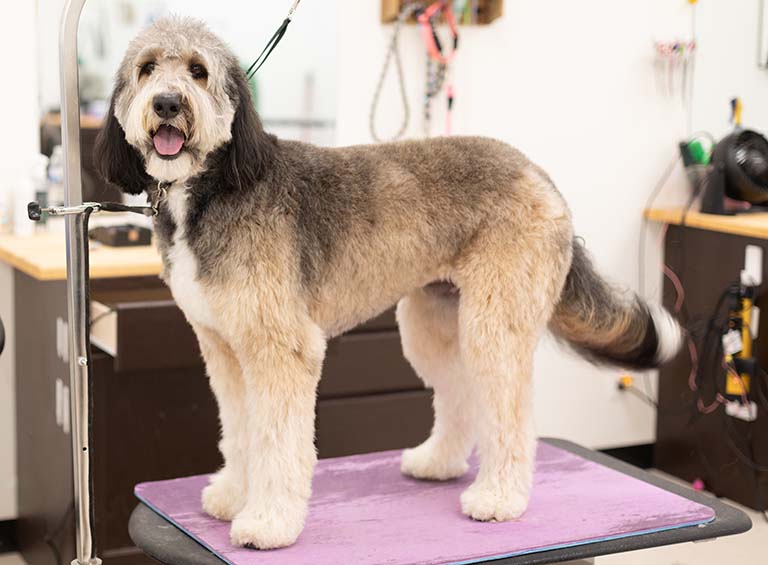Doodles, with their endearing personalities and unique coat textures, have become beloved companions in many households. As crossbreeds, doodles exhibit a fascinating blend of characteristics, making them both charming and distinctive. However, their diverse coat types and specific grooming needs require careful attention and maintenance to ensure their health and well-being.
In this blog, we’ll delve into the world of doodles, exploring what they are and the fascinating variety of coat types they can have. We’ll discuss the common coat and skin problems that doodles may encounter and why maintaining a consistent grooming routine is crucial for their well-being. Additionally, we’ll provide practical tips and techniques for performing doodle maintenance at home, ensuring that your furry friend remains healthy and happy.
What is a Doodle?
A doodle dog, also known as a designer dog, is a crossbreed between a poodle and another dog breed. The most common doodle mixes include the labradoodle (Labrador retriever crossed with a poodle) and the goldendoodle (golden retriever crossed with a poodle). The term “doodle” has become a sort of catch-all for various poodle mixes, leading to other doodle breeds like the bernedoodle (Bernese mountain dog and poodle crossbreed) and the sheepadoodle ( Old English sheepdog and poodle crossbreed) and many more. Because of the great variety of different poodle crosses, it is impossible to accurately predict your doodle’s size, temperament and looks.
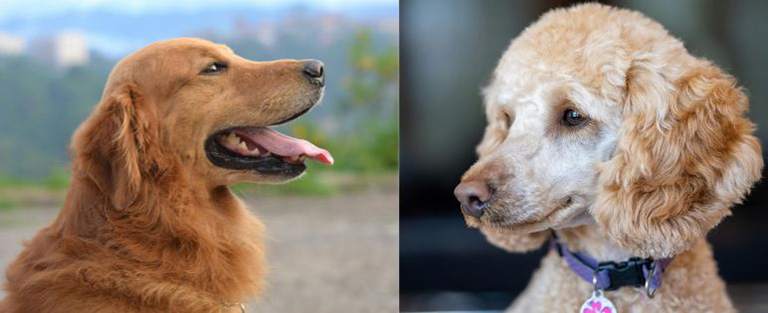
Types of Doodle Coats
Curly Coat
Doodles with curly coats often have tight, spiral curls similar to those of a poodle. This type of coat is typically low shedding and causes less allergic reactions but still requires regular grooming to prevent matting. Curly coats are prone to tangling, so daily brushing and combing is essential to keep the coat free of mats and tangles.
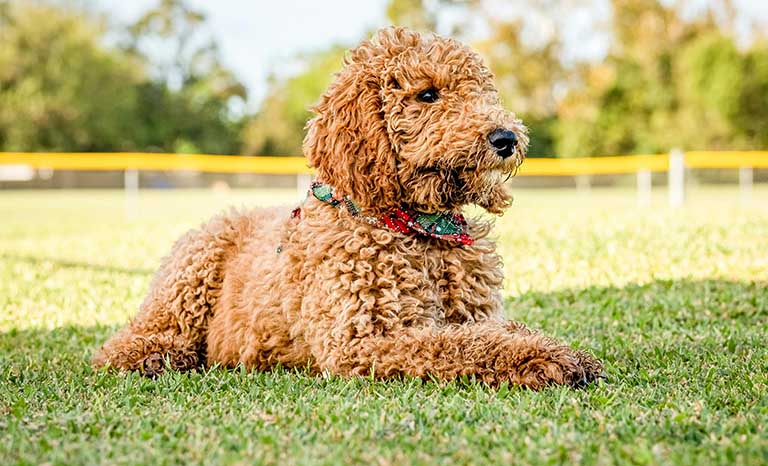
Wavy Coat
Doodles with wavy coats have hair that falls somewhere between straight and curly, forming gentle waves throughout. Wavy coats are also typically low shedding and are less allergenic but may require less maintenance compared to curly coats. Regular brushing a few times a week with a brush or comb can help prevent mats and keep the coat looking neat. Grooming is needed to trim the coat and maintain its shape.
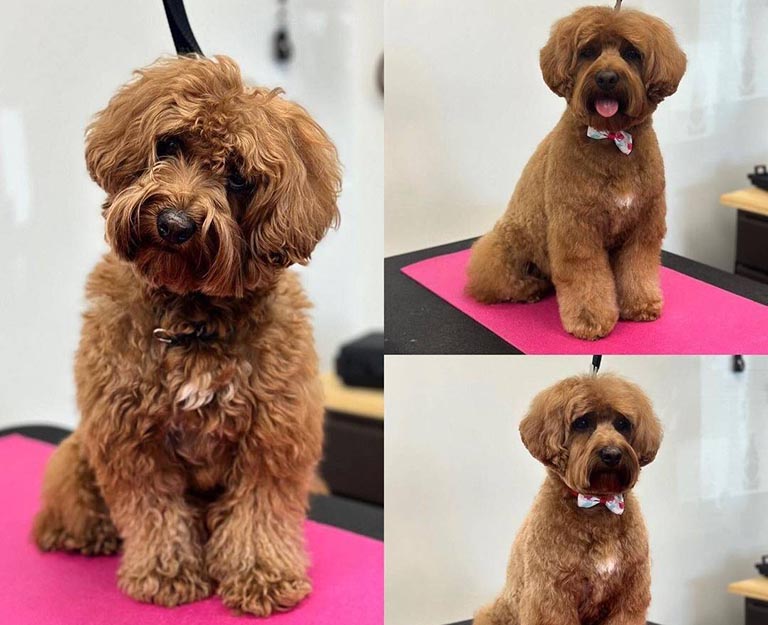
Straight Coat
Some doodles may inherit a straight coat from their non-poodle parent breed, although this is less common. Straight coats are usually easier to maintain than curly or wavy coats, requiring less frequent brushing and grooming. However, even straight coats benefit from regular brushing to remove loose hair and prevent mats. Stay on a schedule for baths and grooming to keep the coat clean and healthy.
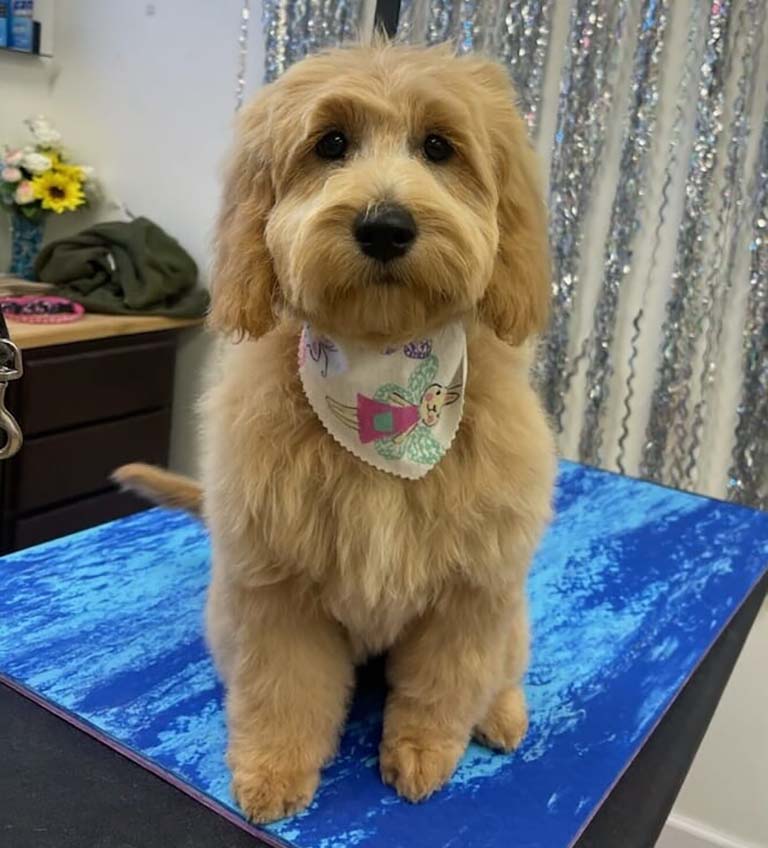
Wire Coats
Wire coated doodles often inherit traits from recessive genes, making them increasingly prevalent. These dogs shed heavily and require regular grooming to manage their dense undercoat. While their fur grows slower compared to other types, neglecting grooming can lead to matting issues.
Mixed Coat
Due to their mixed heritage, many doodles display a blended coat type. A mixed coat often combines curly and wavy or curly and straight hair shafts. While the curly coat gene typically dominates, the recessive gene from the other parent’s coat type can influence the mix, sometimes varying across different body areas. For instance, a doodle might have a straight coat on their face and tail, but curly fur on their body. These variations necessitate regular grooming to maintain their coat health.
Common Skin and Coat Doodle Problems
Coat Issues
Combination Coat: Doodles can display a fascinating mix of coat types, often varying across different parts of their bodies due to their heritage as a cross between a double-coated dog and a poodle. This combination can present unique grooming challenges, as conflicting coat types may emerge. For instance, a doodle might have curly poodle-like hair on one part of their body and straight or wavy hair reminiscent of their double-coated parent breed on another. Managing such dual coat types requires careful attention to each area’s specific needs, including tailored grooming techniques and products. This diversity in coat textures adds to the individuality and charm of doodles but also underscores the importance of understanding and addressing their unique grooming requirements.
Matting: Matting is the result of hair tangling into clumps, wrapping around itself and trapping dead fur. Dogs with a combination of curly hair and a double coat, like doodles, are especially prone to matting. The longer mats stay, the tighter they become, leading to discomfort and potential skin issues. Severe matting can cause skin infections and dandruff, and may also provide hiding spots for parasites like fleas and ticks. Both wet fur from rain or snow as well as wearing doggy coats, harnesses or collars can contribute to matting. Doodles, in particular, are highly susceptible to matting.
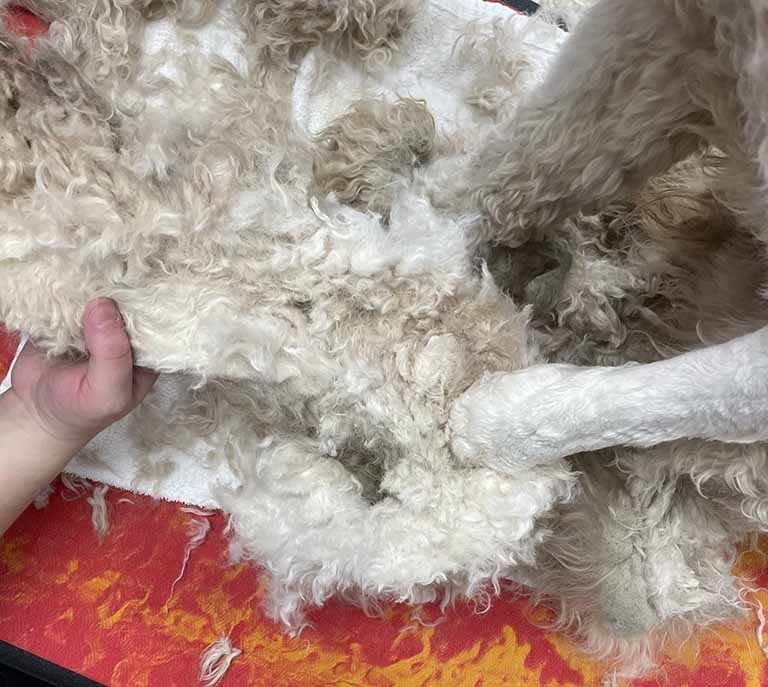
Skin Issues
Doodles are susceptible to skin irritation, allergies and dryness, increasing their risk of skin infections. Common symptoms include redness, itchiness, dandruff, skin sores, odor and recurring ear infections. Labradors, golden retrievers and poodles rank among the breeds most susceptible to allergies, a trait often inherited by doodles. Allergies in these dogs can arise from environmental triggers or food-related sensitivities.
Ear Infections
Golden retrievers, Labradors and poodles are particularly prone to chronic ear infections due to their charming yet droopy ears, which can easily trap heat, moisture and debris, creating an ideal environment for bacterial growth. Doodles inherit this susceptibility from their parent breeds. Watch out for symptoms such as frequent head shaking, persistent pawing at the ears, redness, foul odor, moisture buildup and increased sensitivity in the ears. These signs indicate the need for prompt attention to prevent discomfort and complications.
Setting Up a Grooming Routine
Establishing a regular grooming routine is crucial for doodles due to their propensity for matting and susceptibility to skin and ear infections. Regardless of their coat type, doodles should be groomed every 4-6 weeks, with those sporting longer coats requiring even more frequent attention. Consistent grooming maintenance is essential for preserving their coat and skin health, emphasizing the importance of a structured grooming schedule.
The Benefits of Using Professional Groomers for Doodles
Professional grooming offers numerous benefits for doodle owners. Doodle coats can be complex to trim and time-consuming to dry, depending on their thickness and curl. In many cases, it’s best to entrust grooming to a trained professional who knows how to handle doodle coats effectively.
Pet salons like Smoochie Pooch provide comprehensive grooming packages that include ear cleaning and nail trimming at no extra charge. This means you can drop off your furry friend for a spa day, confident that they’ll receive expert care. Plus, opting for professional grooming means no mess to clean up at home. It’s a win-win situation for both you and your doodle!
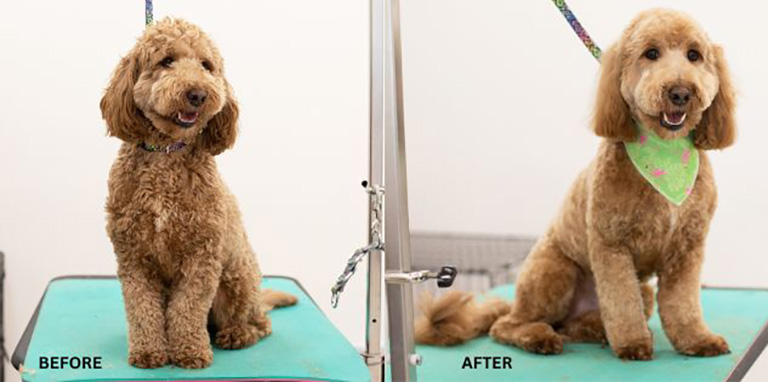
Doodle Haircuts
To effectively communicate your desired doodle haircut to your groomer, start by understanding your dog’s coat type. Once you’re aware of this, search for images of similar doodles with the same type of coat and discuss the possibility of achieving a similar haircut with your groomer. It’s important to be clear about your preferences while also keeping your expectations realistic. This approach ensures that you and your groomer are on the same page, leading to a haircut that meets your expectations while considering your doodle’s coat characteristics.
Discuss with your groomer what exactly you mean by a “close” shave or “long” hair, as length terms can vary from personal preferences. Describing the desired amount of hair to keep on your dog’s body can often be more straightforward than specifying how much you want to be removed. It’s essential to communicate the desired length for various body parts, such as the ears, tail, face, feet and body. Discussing guard lengths with your groomer and seeking their input can help determine the most suitable option for achieving your preferred aesthetic.
Note: At Smoochie Pooch, we prioritize your dog’s well-being above all else with our “humanity before vanity” approach. If your doodle is severely matted, we won’t subject them to the discomfort and potential pain of extensive brushing. Instead, our groomers will consult with you and recommend shaving out the mats, which may involve shaving the entire dog. We believe in transparent communication and ensuring the best possible experience for your furry friend.
Popular Doodle Haircuts
Panda Clip or Teddy Bear Trim: Many doodle owners opt for this favored trim, characterized by a closely clipped body and longer, fluffy legs, often accompanied by short ears and a charmingly round face. When requesting this style from your pet groomer, describe it as a shorter body, fuller legs and a rounded facial shape. Providing a photo reference to your groomer can be especially beneficial!
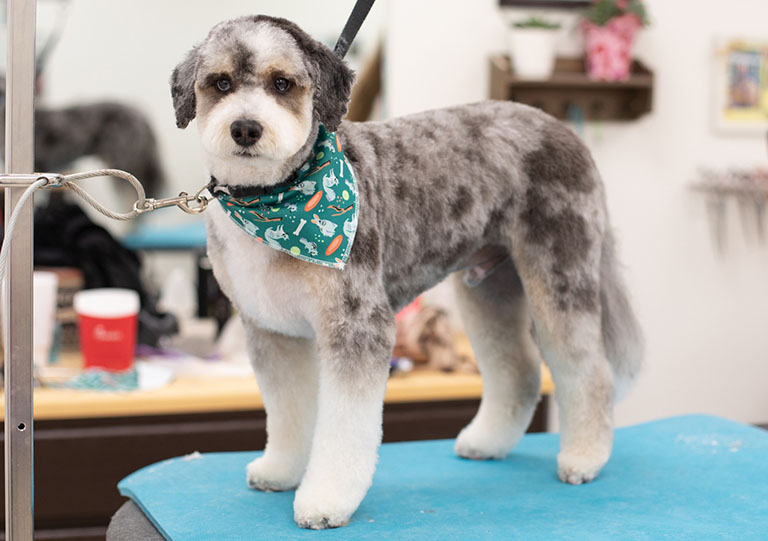
Retriever trim or Puppy Trim: This trim generally entails a haircut where the fur is kept at a uniform length all over, typically on the shorter side. Since one’s understanding of “short” can vary from person to person, it’s important to clearly communicate your desired length when you bring your doodle to a professional groomer. While these trims can vary widely based on owner preference, they typically involve maintaining the same length of fur across the body and legs, with specific attention to the head.
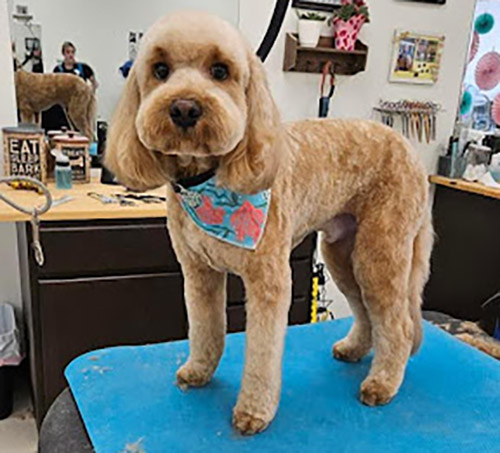
Full Shave: Some doodles are shaved at the request of their owners, often for reasons such as frequent swimming or easier maintenance. Unfortunately, doodles, like any breed requiring regular grooming, can experience severe matting, necessitating shaving for safety reasons. In such cases, professional pet groomers strive to ensure the dog’s comfort while making them look as adorable as possible. When dealing with matting, groomers use blades that can safely separate the skin from the coat. This often results in leaving about ¼” of hair on the dog or sometimes even shorter.
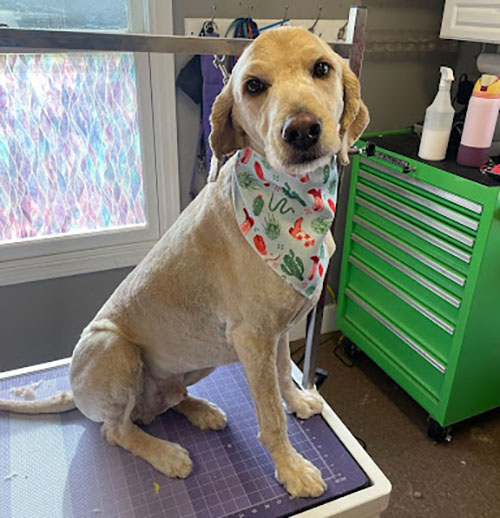
Doodle Maintenance at Home
Bathing Basics
It’s recommended to bathe your doodle at least once a month.
- Preparation: Gather all necessary supplies, including dog shampoo, towels, a brush and a hairdryer. Place a non-slip mat in the bathtub to prevent your doodle from slipping. If the dog is not a fan of the tub, you can use a slip lead attached to a suction cup to keep the dog in the tub.
- Brushing Out Mats and Tangles: If your dog has mats and tangles, it’s essential to brush and comb them out before they become wet. However, if their coat is already in good condition, you can skip this step, as brushing dirty hair may lead to unnecessary breakage.
- Shampoo Selection: Choose a mild, dog-specific shampoo that is suitable for your doodle’s coat type. Dogs have a different pH than humans, and dog shampoo is specifically designed with this in mind. Even baby shampoo is too harsh on a dog’s skin as it is not designed to be compatible with their pH.
- Conditioner Selection: Just like with shampoo, opt for a conditioner specifically designed for dogs. After bathing, it’s important to condition their coat to moisturize both their fur and skin.
- Water Temperature: Ensure the water temperature is comfortable for your doodle, neither too hot nor too cold.
- Wetting the Coat: Gently wet your doodle’s coat with water, starting from the neck and working your way down to the tail. Be cautious around the ears and face to prevent water from getting into your dog’s eyes and ears.
- Shampoo Application: Many shampoos come in concentrated forms and are meant to be diluted, which is recommended for most high-quality shampoos. Check the label to find the recommended dilution ratio. You can purchase an affordable mixing bottle on Amazon that includes dilution rates printed on the outside. Simply fill the bottle with water up to the recommended dilution level, then add the shampoo until the bottle is full. Shake the bottle well to mix the shampoo and water thoroughly. Apply a small amount of dog shampoo to your doodle’s coat, focusing first on areas that are particularly dirty or greasy. Massage the shampoo into the coat, paying attention to the skin beneath the fur. Let the shampoo sit in the pet’s coat for a few minutes for best results before rinsing it out. Refer to the instructions on the shampoo bottle you are using to know how long to let the shampoo rest.
- Rinsing: Thoroughly rinse your doodle’s coat with lukewarm water to remove all traces of shampoo. Ensure that no soap residue remains, as it can cause skin irritation.
- Conditioning: Condition your dog utilizing the dilution rate indicated on your product packaging. Like the shampoo step, it’s recommended to focus on dirty areas first and proceed to massage it into the rest of the coat and skin. For best results, allow the conditioner to remain in the pet’s coat for a few minutes before rinsing it out. Consult the instructions provided on the conditioner bottle to determine the recommended duration for leaving the conditioner in.
- Drying Techniques: Use a towel to gently pat your doodle’s coat dry, absorbing as much water as possible. Avoid rubbing, as this can cause tangles and mats. If your doodle tolerates it, you can use a hairdryer on a low heat setting to speed up the drying process. Be sure to keep the dryer moving and maintain a safe distance from your dog’s skin to prevent overheating.
- Brushing: As you use a hair dryer on your doodle’s coat, you can simultaneously brush to achieve an extra fluffy appearance. If you don’t brush while drying, make sure to give their coat a thorough brush and comb-through once the pet is dry to leave the coat smooth and shiny. We recommend using a brushing spray like this one to minimize excessive coat damage caused by brushing.
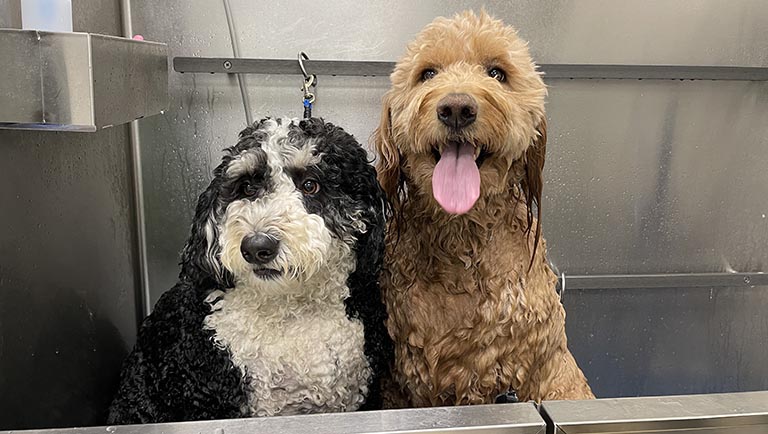
Brushing and Detangling
For doodles with curly or wavy coats, daily brushing and combing are essential to prevent matting. Those with straight hair can typically get by with weekly brushing and combing. It’s crucial to brush and comb your doodle after activities like swimming, rain or snow, as water can cause mats to form easily. Additionally, always groom your doodle after removing a sweater, harness, collar or coat. Consistent grooming not only prevents matting but also helps you detect any fleas, ticks or signs of a skin infection. Ultimately, regular grooming keeps your doodle looking and feeling their best.
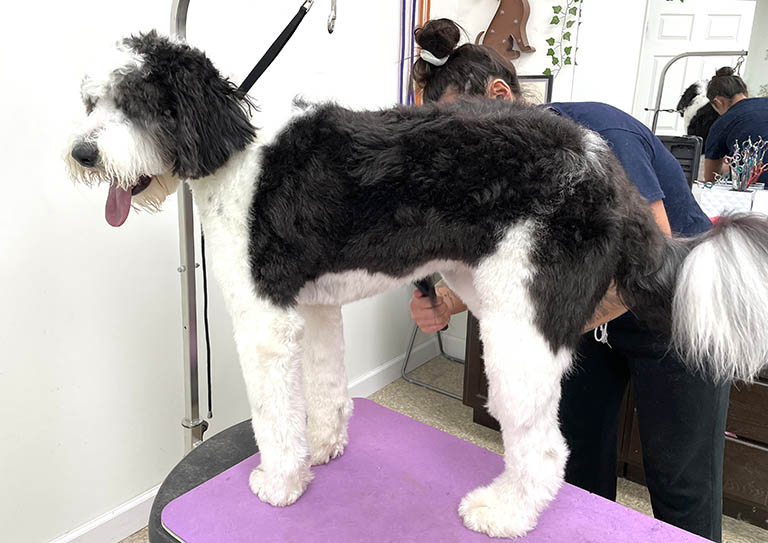
Types of Brushes
The most effective tools for grooming a doodle are a slicker brush and a metal comb. The slicker brush efficiently detangles and removes loose hair, reducing the risk of matting. It’s particularly useful for doodles with a combination coat of thick fur and curly hair.
After using the slicker brush, it’s advisable to follow up with a metal comb. A fine-toothed comb is excellent for dematting and addressing any knots that the slicker brush may have overlooked. Always brush in the direction of the hair growth for best results. Ensure that the comb reaches all the way to the bottom of the hair and gently reaches the skin while combing.
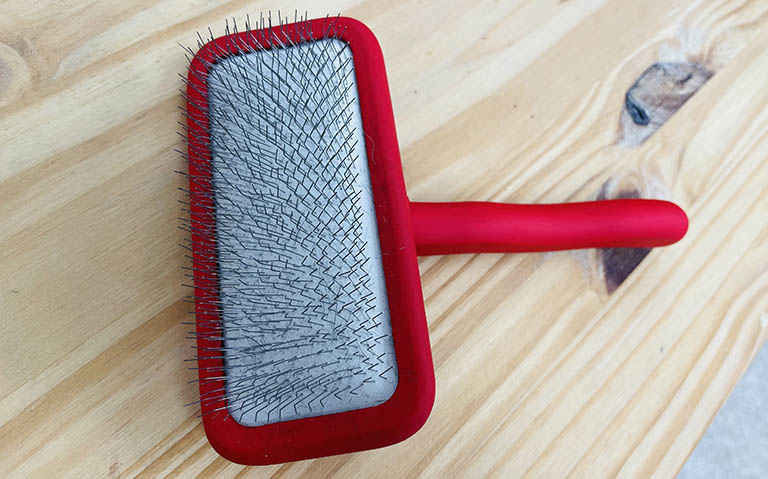
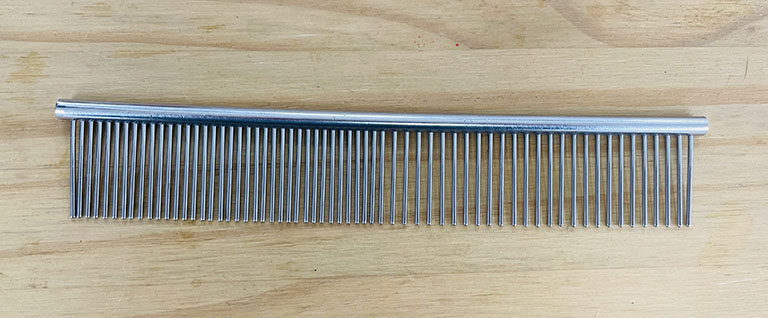
Ear Care
After each grooming and bathing session, it’s crucial to thoroughly dry and wipe your doodle’s ears. Excess moisture in the ear canal creates an ideal environment for microorganisms to thrive, leading to infections, odors and discomfort for your pet. Consistent drying removes moisture, reducing these risks while maintaining the ears’ natural defenses and supporting overall ear health.
While only a vet can access the inner ear canal, you can safely clean the area visible to the eyes using a veterinarian-approved ear cleaner for dogs. Apply a small amount of cleaner to a cotton swab and gently clean only the visible parts of the ear. Avoid pouring any liquids, including ear cleaner, into the ear canal, as this can lead to serious infections. Ideally, there shouldn’t be a significant amount of debris in the ear. If excessive debris persists consult your vet.
If wiping your dog’s ears seems intimidating, consider bringing them to your local pet salon, where ear cleaning may be included in the basic grooming package.
Ear Plucking: If your dog’s ears are free from any issues related to hair, it’s generally best to avoid plucking ear hair. However, if chronic ear infections are a concern and hair in the ears is confirmed by a veterinarian to be the cause, seek the assistance of a veterinarian or professional groomer to address the issue. It’s important not to initiate this practice without consulting your veterinarian beforehand.
Nail Care
Pet owners frequently inquire about the appropriate nail trimming frequency for their dogs. Ideally, dogs should have their nails clipped and filed every 4-6 weeks. Owners can choose to have both cutting and filing done or opt to only do one or the other based on their dog’s comfort level.
How-To Steps for Cutting Dog’s Nails at Home
- Begin by gently picking up your dog’s paw and placing your thumb on the pad of a toe, with your forefinger on the top of the toe above the nail. This positioning helps extend the nail for easier trimming.
- Clip only the tip of the nail, making sure to cut straight across. Avoid clipping beyond the curve of the nail, as this could result in hitting the quick. The general recommendation is to trim approximately 2mm away from the quick to avoid causing injury.
- When cutting the nail, be decisive and make a smooth, quick motion while securely holding the nail steady to minimize any potential risks or discomfort for your dog. Ensure your nail clippers are sharp to prevent unnecessary stress on the nails.
Remember to approach trimming your dog’s nails with patience and caution. Creating a positive and stress-free environment can make the process easier and more enjoyable for both you and your canine. If you are struggling or are uncomfortable with doing this service at home, allow your local pet groomer to trim and file your dog’s nails.
Caring for Your Doodle
Caring for a doodle dog involves more than just providing food and shelter — it requires commitment to their grooming and maintenance needs. By understanding their coat type, recognizing potential grooming challenges and establishing a regular grooming routine, you can help your doodle look and feel their best. Whether you choose to groom them at home or enlist the help of professional groomers, prioritizing their well-being ensures a happy and healthy life for your beloved doodle companion.


